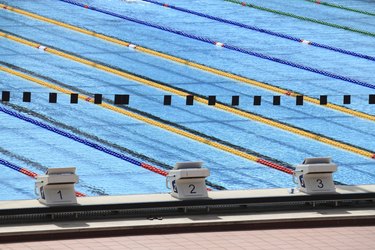
Before you complete U.S. Navy basic training, you must qualify as a Third-Class Swimmer. Further testing is required to qualify for advanced positions within the Navy, but all are based on the Swim Skills Assessment Test. You must be comfortable enough in the water that you appear relaxed throughout the test, as outlined in the Navy Swim Guidelines.
Swim Skills Assessment
Video of the Day
The basic Swim Skills Assessment measures your ability to swim 15 yards in chest-deep water, swim another 15 yards in water over your head, tread water for one full minute and float facedown for one full minute. Basic swimming lessons teach all of these skills, and you should be comfortable with them before entering basic training. The Navy offers remedial swimming classes for those who don't pass this minimum skills test--but in the military, your goal is to exceed the requirement, not just pass. The swim test for the Third-Class Swimmer includes the basic Swim Skills Assessment Test, in addition to a few more skills that ensure you can survive in open water without a flotation device in a man-overboard situation.
Video of the Day
Deep-Water Jump
You must be able to jump into deep water from a 5- to 10-foot platform and find your way back to the surface easily. This activity simulates jumping ship and entails a particular set of rules regarding body positioning. You must not bend at the waist, and your head should be held high. You legs should be crossed at the ankle, and your arms should be crossed over your chest. You should use your inside arm to pinch your nose, bracing your hand by placing your pinky under your jaw. This keeps you from losing your grip from the impact of hitting the water.
50-Yard Swim
You must be able to swim 50 yards without stopping or holding on to the side of the pool. You must demonstrate proper technique in the front crawl, breaststroke, backstroke and elementary backstroke. The Navy has very specific instructions for each stroke, mostly regarding breathing and propulsion techniques. Learn the proper kick for each stroke and learn to exhale underwater, so that you have to inhale only when you come up for breath. Practice technique to coordinate arm and leg movements for optimum propulsion.
Float/Inflation
The prone float and clothing inflation are techniques you employ to stay afloat while waiting for rescue, so your skills must be solid. The Third-Class Swimmer test requires you to float facedown for 5 minutes in any position, exhaling through the nose and mouth and pivoting at the neck to inhale through mouth. Your arm and leg movements should keep you on the surface, but excessive positional movement is unacceptable. For the inflation test, you may use any method to fill your shirt and trousers with air, but you must stay close to the surface for the entire process. Your clothing must be inflated enough for you to float without moving; struggling and sinking are not allowed.